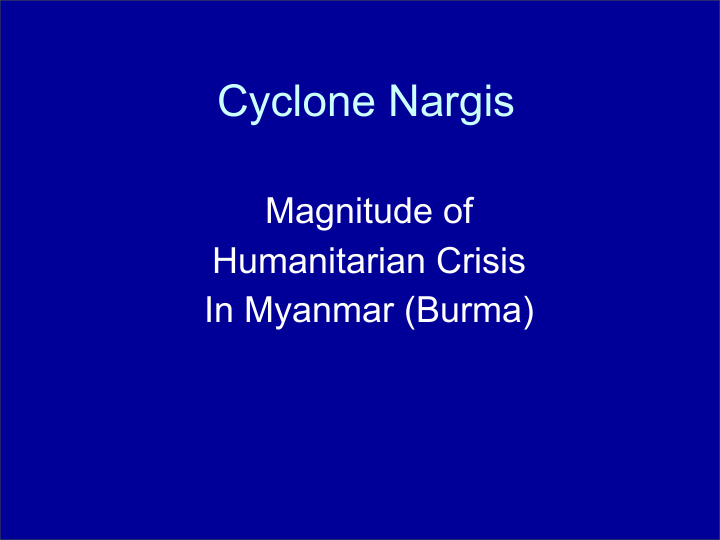



Cyclone Nargis Magnitude of Humanitarian Crisis In Myanmar (Burma)
Strength of the Storm • On May 2, Cyclone Nargis made landfall in the Irrawaddy division in Myanmar with peak winds of 215 km/h (135 mph) as it approached the delta coast • Cyclone pushed a wall of water, as high as 12 feet, approximately 25 miles (40 kilometers) inland over a low-lying, densely populated delta region
"It would create a big storm surge. It was like Katrina going into New Orleans." * Mark Lander Meteorology professor University of Guam *Katrina at landfall had sustained winds of 120-125 mph at Louisiana/ Mississippi border
Cyclone Nargis
Population at risk • Estimated population of Myanmar is 55 million (24 th largest in the world) • Population in Irrawaddy delta: 6 -6.5 million (Burmese, Karen, Mons and Indians) – most populous of Myanmar’s states and divisions • Population under 5 year: 400, 000 -600, 000 • Population under 18 year: 1.8 to 2.2 million • Area 13,566 sq-miles (cf Belgium = 11 787 sq-miles) • The average population density 466 persons per square mile (New York state = 401, Texas = 79) • Percentage of people with safe drinking water: 72%
Before and After
Assessment by WHO • Estimated numbers are at in excess of 100, 000 dead, 200, 000 missing and 2 millions population severely affected • As of 7 May, 2008, the figures for those killed, missing or affected are still not definitive. The state media is reporting the death toll at 22 980 deaths and 42 119 missing. Population severely affected not announced. • These figures may be conservative and are expected to rise as more information becomes available and the delta areas are assessed objectively
Assessment by WHO • A storm surge is reported to have destroyed the vast majority of domestic dwellings in seven townships, also causing severe storm and flood-damage to roads, communication links and other essential service infrastructure, especially water and power supplies. Such damage will hinder and complicate assessment and response efforts and increase the risk of infectious disease. • Access to the public health system, which was already inadequate, has also been severely affected, and the capacity of the surveillance system to detect and respond to epidemics has been further weakened.
Potential Economic Impact • The areas devastated by the cyclone and flooding produce: – 65% of the country's rice, – 80% of the agriculture – 50% of poultry – 40% of pig production (FAO). • Damage to these industries will have a longer term effect not only on domestic supply but also on importing countries which purchase rice from Myanmar such as Bangladesh and Sri Lanka
Rice- our staple food • Myanmar per capita rice consumption is the highest in the world ~ > 200 kg/ year (milled rice) (Cf world average ~ 60-80 kg/year) • 1 million ton shortage would translate to lack of stable food supply for up to 4 millions people • Forbes projects 7-10% destruction (2-2.5 million tons of paddy) in the delta area from the direct effect of the storm.
Risk factors for increased communicable disease burden (WHO) • Interruption of safe water, sanitation and cooking facilities due to disruption of electricity and fuel supplies – The populations displaced by the cyclone are at immediate and high risk of outbreaks of waterborne and foodborne diseases • Population displacement with overcrowding – Populations in the affected areas and relief centers are at immediate and high risk from the transmission of measles and at increased incidence of acute respiratory infections (ARI). In general increased risk of meningitis transmission is associated with overcrowding. • Increased exposure to disease vectors – Displacement of populations can result in increased exposure to disease-carrying vectors, increasing the risk of malaria and dengue. As well as other endemic illnesses such as typhoid and leptospirosis. There is a concern for development of less reported disease such as plague, chikungunya and hantavirus infection.
Risk factors for increased communicable disease burden (WHO) • Malnutrition and transmission of communicable diseases – The combination of malnutrition and communicable diseases with a natural disaster creates the potential for a significant public health problem particularly in infants and children. Malnutrition compromises natural immunity, leading to more frequent, severe and prolonged episodes of infections. Severe malnutrition often masks symptoms and signs of communicable diseases, making prompt clinical diagnosis and early treatment more difficult. • Poor access to health services – The damage caused by the cyclone to the health infrastructure is preventing access to usual services, as well as to emergency medical and surgical services being put in place in response to this emergency. • Increased malaria vector – breeding resulting in increased malaria transmission will become an issue (usually after 2-3 weeks)
Conclusion • Due to a unique social, economic and political situation, humanitarian emergency in Myanmar has a potential to escalate into a disaster of severe magnitude with millions of more people at risk of perishing • It is anticipated material support alone is not likely to be sufficient. Support in logistics, man-power and above all effective intervention at every levels of the community must be promptly effected • In addition, sustained and resilient engagement by the international community with a view to identifying and overcoming obstacles at various levels is urgently needed to avert a potential catastrophe
References • www.nytimes.org • Food Agricultural Organization (FAO) • World Health Organization (WHO) • United Nations Development Programme (UNDP) • United Nations International Children ’ s Fund (UNICEF) 17
Recommend
More recommend